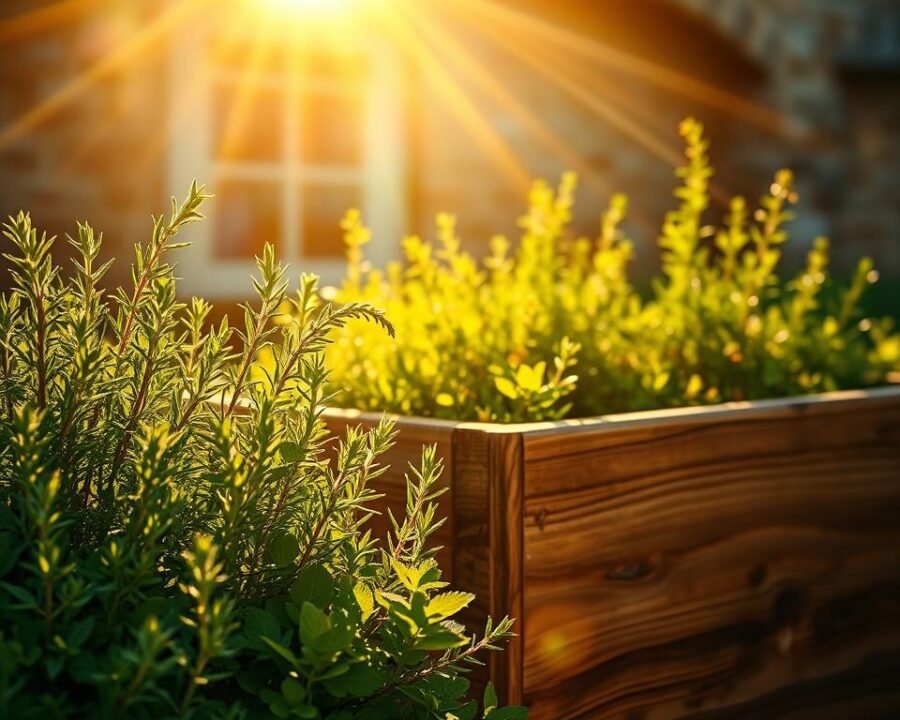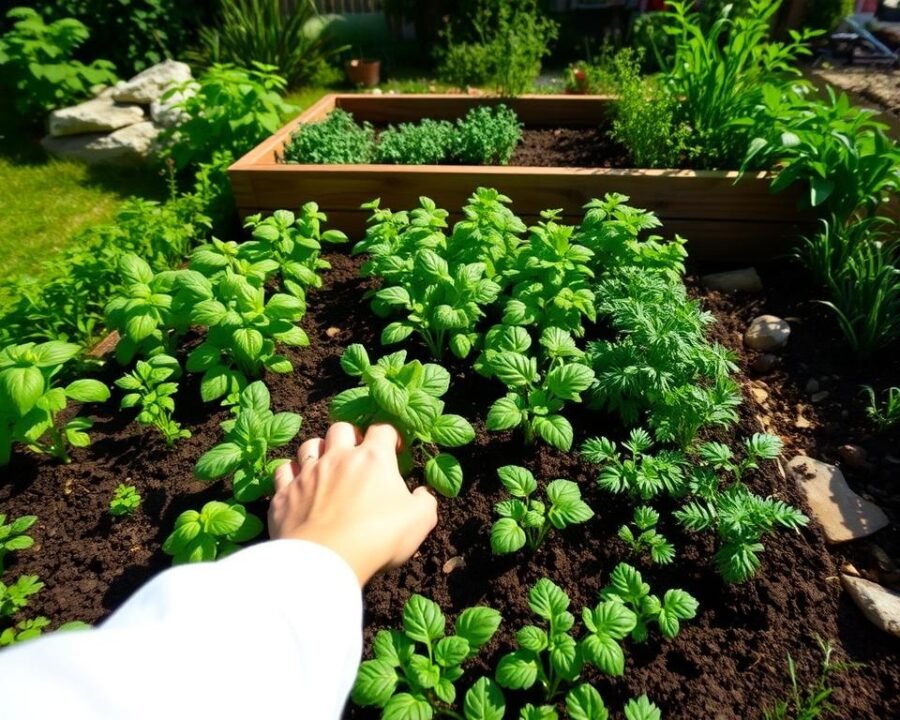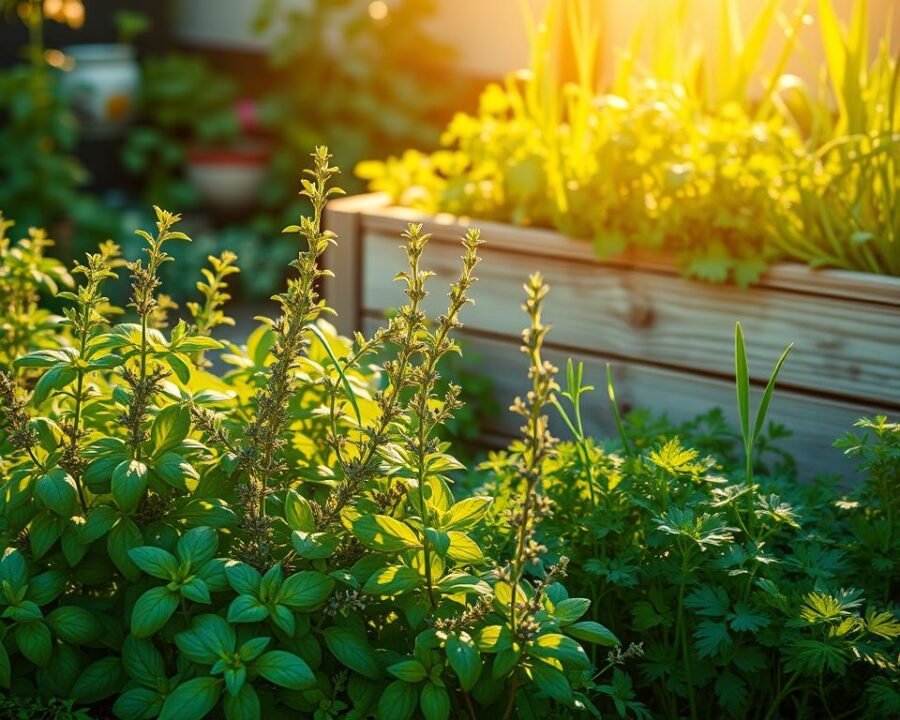There’s something magical about plucking fresh herbs right from your own garden. The aroma, the taste, and the satisfaction of knowing exactly where your food comes from—these little green wonders transform meals into memorable experiences.
More people are embracing the joy of cultivating their own kitchen garden. Whether you have a sunny windowsill or a backyard plot, fresh herbs grow effortlessly with the right care. No more last-minute store runs—just step outside and snip what you need.
For over two decades, we’ve helped beginners and experts alike create thriving spaces filled with basil, mint, rosemary, and more. In this guide, we’ll share practical tips for selecting plants, optimizing conditions, and keeping your herb garden flourishing year-round.
Key Takeaways
- Fresh herbs enhance meals and reduce grocery costs.
- Both indoor and outdoor setups work for cultivation.
- Proper care ensures continuous harvests.
- Quality plants yield better flavor and growth.
- Seasonal adjustments keep gardens productive.
1. Sourcing Quality Herbs: Skip the Big-Box Stores
Not all herb plants are created equal—choose wisely. Chain-store options often carry hidden drawbacks, from synthetic treatments to stressed roots. For robust flavors and longevity, local sources outshine mass-produced alternatives.
Why Local Nurseries and Growers Are Better
Small-scale growers prioritize health over shelf life. Their plants adapt to regional conditions, reducing transplant shock. Ask about cultivation methods: organic practices and pest management reveal a lot.
Key questions for local sellers:
- Do you use chemical fungicides or fertilizers?
- How are the herbs acclimated to our climate?
- Can I see the root system before buying?
Starting from Seed vs. Cuttings: Which Herbs Work Best?
Some herbs flourish from seed, while others root faster from cuttings. Basil, parsley, and dill sprout reliably from seed. For rosemary or mint, snip a stem—it’s quicker and clones the parent plant’s traits.
Trusted organic seed sources we recommend:
- Baker Creek Heirloom Seeds
- Botanical Interests
- High Mowing Organic Seeds
Start with one packet per variety. A single planting yields enough for recipes, drying, and sharing.
2. Choosing the Right Location for Your Herb Garden
Location determines whether your herbs thrive or barely survive. A sunny patio or a bright kitchen ledge can yield lush harvests with minimal effort. We’ll help you match your space to the perfect setup.
Indoor vs. Outdoor Growing: Pros and Cons
Outdoor gardens soak up natural sunlight, but indoor setups offer year-round control. Balconies suit rosemary and thyme, while basil thrives near a sunny window. Here’s a quick comparison:
- Outdoor: Better airflow, natural pollinators, but weather risks.
- Indoor: Consistent temps (50–60°F nights), no pests, yet limited sun.

Sunlight and Space Requirements for Thriving Herbs
Mediterranean varieties (oregano, lavender) demand 6+ hours of direct sun. Leafy types (parsley, mint) tolerate partial shade. East or west-facing windows work for most, but avoid north-facing except for shade-loving mint.
For tight spaces, try compact varieties like dwarf basil or chives. Our balcony garden flourished in 12-inch containers—proof that small footprints can still yield big flavors.
3. Planting Your Herbs the Right Way
Healthy roots start with smart planting—whether in pots or garden beds. A little planning prevents wilted leaves and stunted growth. Here’s how to set up your plants for success.

Container Gardening: Pots, Soil, and Drainage Tips
Choose containers based on your herb’s needs. Oregano thrives in a 6-inch pot, while mint demands a 12-inch one to spread its roots. Always pick vessels with drainage holes—soggy soil kills more herbs than neglect.
Layer the soil for balance:
- Bottom: Gravel or broken pottery for drainage.
- Middle: Organic potting mix with compost.
- Top: Light mulch to retain moisture.
Clay pots breathe better but dry faster. Plastic holds water longer—ideal for thirsty basil. Once, we used an oversized container for sage; the excess soil stayed wet, and the roots rotted within weeks.
Direct Ground Planting: Preparing the Soil
For ground planting, test the soil pH first. Most herbs prefer 6.0–7.0. Mix in compost and sand if drainage is poor. Sage and oregano love gritty, lean beds—avoid heavy clay.
Essential tools for aeration:
- Hand fork
- Garden claw
- Soil knife
Pair rosemary with beans—they deter pests. Basil boosts tomato flavor when planted nearby. Smart combinations save space and enhance growth.
4. Essential Care Tips for Healthy Herb Plants
The secret to lush, aromatic herbs lies in mindful maintenance. With simple routines, your garden will reward you with vibrant flavors and endless harvests. Here’s how to nurture them like a pro.
Watering and Pruning: Less Is Often More
Overwatering drowns roots, while neglect starves them. Use the knuckle test: if soil feels dry an inch down, it’s time to water. Mint craves dampness, but thyme prefers dryness—adjust accordingly.
Prune basil above leaf nodes to encourage bushiness. Snip yellowing leaves promptly to redirect energy. Our rule: never remove more than ⅓ of the plant at once.
Organic Fertilizers and Pest Control
Boost growth with kitchen scraps. Try these easy recipes:
- Banana peel tea: Soak peels in water for 48 hours—rich in potassium.
- Eggshell powder: Crush dried eggs for calcium.
- Compost brew: Steep finished compost for nutrient-rich liquid.
Aphids hate neem oil sprays. For fungus gnats, sprinkle cinnamon on pot soil. Spotty leaves? Check for overwatering or spider mites.
Harvest in the morning for peak flavor. Always leave enough leaves for photosynthesis. With these steps, your herbs will thrive season after season.
5. Seasonal Adjustments: Keeping Herbs Alive Year-Round
Year-round herb cultivation requires smart seasonal strategies. In Connecticut winters, we’ve learned which varieties survive indoors and how to revive them when summer returns. With careful timing, your garden can thrive all year.

Winter Herb Gardening Indoors
Not all herbs adapt to indoor life. Rosemary and basil often struggle with low light, while mint and oregano flourish. Our top picks for winter:
| Herb | Flavor Profile | Light Needs |
|---|---|---|
| Winter Savory | Peppery, pine-like | 4–6 hours sun |
| Thyme | Earthy, slightly sweet | 6+ hours |
| Parsley | Fresh, grassy | Moderate light |
| Oregano | Bold, aromatic | Bright indirect |
| Sage | Warm, slightly bitter | Direct light |
For continuous harvests, follow an indoor herb schedule. Pinch back Berggarten sage every 3 inches—it grows slower but yields more leaves than common varieties.
Transitioning Herbs Outdoors in Summer
Acclimate plants gradually over 7–10 days. Start with 1 hour of morning sun, increasing daily. Basil may flower in heat; trim buds to prolong leaf production.
- Week 1: Shaded porch for 3 hours/day.
- Week 2: Morning sun, afternoon shade.
- Week 3: Full outdoor exposure.
Perennials like thyme handle cold snaps better. Build a DIY cold frame for early season protection—repurposed windows work perfectly. By rotating indoor and outdoor spaces, your herbs stay vibrant through every season.
6. Conclusion: Enjoy Your Thriving Herb Garden
Fresh flavors from your own space bring joy to every meal. Whether snipping basil for pasta or drying thyme for soups, your garden transforms food into something special.
Celebrate each milestone—from that first cutting to winter harvests. Share your wins with local gardening groups. Many offer tips for tricky varieties.
Homegrown herbs save money and taste better. Compare $3 store packs to free sprigs from your patio. Over time, the savings add up.
Try simple recipes: toss chopped chives into scrambled eggs or blend mint into smoothies. Your kitchen will smell amazing.
Stuck? Reach out to master gardeners online. They love helping beginners.
Start small. A pot of chives needs just sunlight and occasional water. Soon, you’ll crave more herbs—and the pride they bring.
